餐饮网站建设怎样站长工具友链查询
目录
1.Collection单列集合
1.1单列集合各集合特点
1.2、Collection集合
1.2.1、Collection方法
1.2.2、Collection遍历方式
1.2.2.1、迭代器遍历集合
1.2.2.2、增强for遍历集合
1.2.2.3、forEach遍历集合(JDK8之后)
1.2.2.4、遍历案例
1.3、List系列集合(List、ArrayList、LinkedList)
1.3.1、List集合的常用方法
1.3.2、List集合的遍历方式
1.3.3、ArrayList集合
1.3.4、LinkedList
1.3.4.1、LinkedList常用方法、
使用LinkedList设计栈结构、队列结构
1.4、Set系列集合(Set、HashSet、LinkedHashSet、TreeSet)
1.4.1、HashSet集合
1.4.1.1、底层原理(了解)
1.4.1.2、HashSet去重原理(重写hashcode、equals方法)
1.4.2、LinkedHashSet集合
1.4.3、TreeSet集合
2、各集合使用情况
3、集合的并发修改异常
3.1解决方法
4、Collection其他使用
4.1、可变参数
4.2、Collections工具类
集合分为单列集合和双列集合:

1.Collection单列集合
Collection 是单列集合的根接口, Collection 接口下面又有两个子接口List 接口、 Set 接口, List 和 Set 下面分别有不同的实现类,如下图所示:
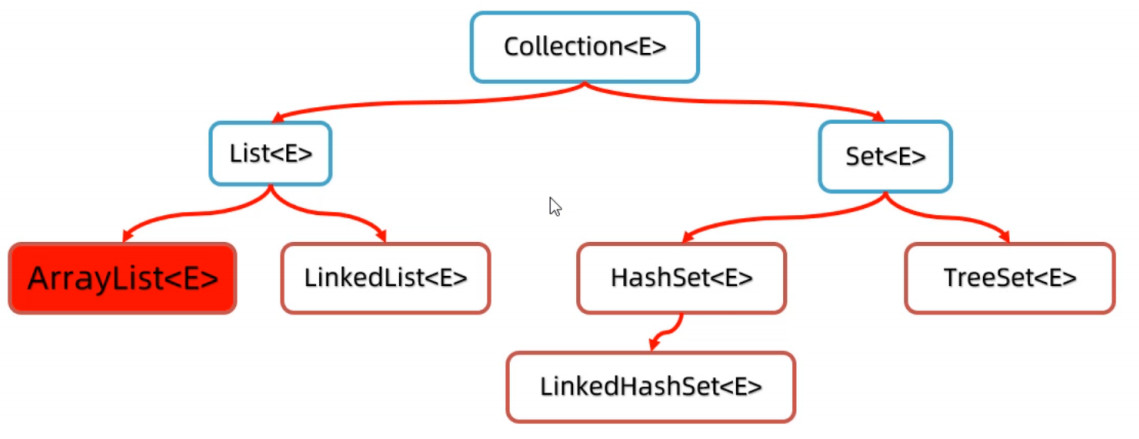
1.1单列集合各集合特点
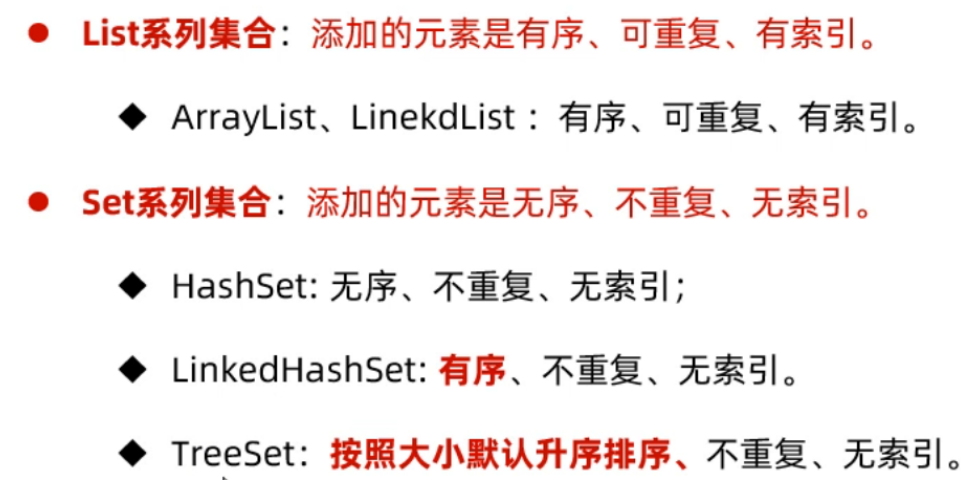
可以自己写代码验证一下,各种集合的特点
// 简单确认一下 Collection 集合的特点
ArrayList<String> list = new ArrayList<>(); // 存取顺序一致,可以重复,有索引
list.add("java1");
list.add("java2");
list.add("java1");
list.add("java2");
System.out.println(list); //[java1, java2, java1, java2]
HashSet<String> list = new HashSet<>(); // 存取顺序不一致,不重复,无索引
list.add("java1");
list.add("java2");
list.add("java1");
list.add("java2");
list.add("java3");
System.out.println(list); //[java3, java2, java1]
1.2、Collection集合
1.2.1、Collection方法
所有 Collection单列集合的实现类都可以使用( ArrayList、LinkedList、HashSet、LinkedHashSet、TreeSet 集合都可以调用下面的方法。 )
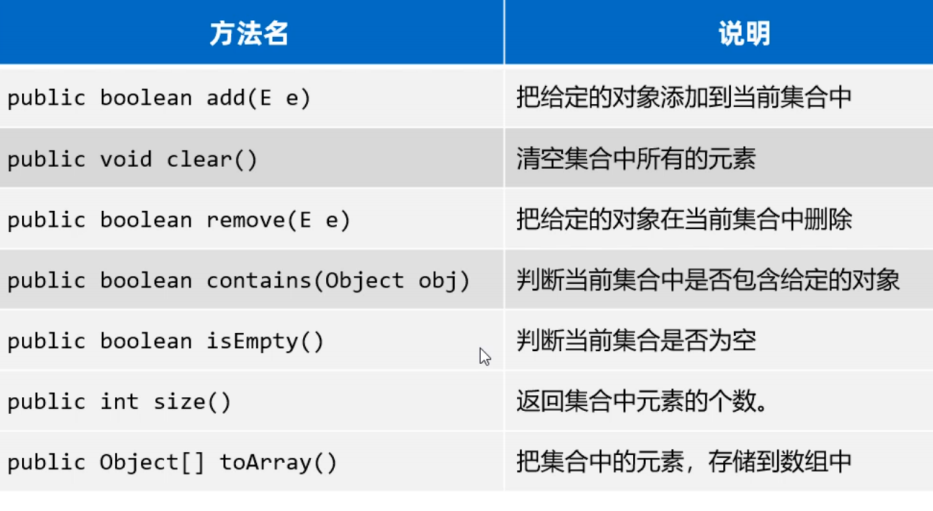
Collection<String> c = new ArrayList<>();//1.public boolean add(E e): 添加元素到集合
c.add("java1");
c.add("java1");
c.add("java2");
c.add("java2");
c.add("java3");
System.out.println(c); //打印: [java1, java1, java2, java2, java3]//2.public int size(): 获取集合的大小
System.out.println(c.size()); //5//3.public boolean contains(Object obj): 判断集合中是否包含某个元素
System.out.println(c.contains("java1")); //true
System.out.println(c.contains("Java1")); //false//4.pubilc boolean remove(E e): 删除某个元素,如果有多个重复元素只能删除第一个
System.out.println(c.remove("java1")); //true
System.out.println(c); //打印: [java1,java2, java2, java3]//5.public void clear(): 清空集合的元素
c.clear();
System.out.println(c); //打印:[]//6.public boolean isEmpty(): 判断集合是否为空 是空返回true 反之返回false
System.out.println(c.isEmpty()); //true//7.public Object[] toArray(): 把集合转换为数组
Object[] array = c.toArray();
System.out.println(Arrays.toString(array)); //[java1,java2, java2, java3]//8.如果想把集合转换为指定类型的数组,可以使用下面的代码
String[] array1 = c.toArray(new String[c.size()]);
System.out.println(Arrays.toString(array1)); //[java1,java2, java2, java3]//9.还可以把一个集合中的元素,添加到另一个集合中
Collection<String> c1 = new ArrayList<>();
c1.add("java1");
c1.add("java2");
Collection<String> c2 = new ArrayList<>();
c2.add("java3");
c2.add("java4");c1.addAll(c2); //把c2集合中的全部元素,添加到c1集合中去
System.out.println(c1); //[java1, java2, java3, java4]1.2.2、Collection遍历方式
1.2.2.1、迭代器遍历集合

代码演示:
Collection<String> c=new ArrayList<>();
c.add("赵敏");
c.add("小昭");
c.add("素素");
c.add("灭绝");
System.out.println(c); //[赵敏, 小昭, 素素, 灭绝]//第一步:先获取迭代器对象
//解释:Iterator就是迭代器对象,用于遍历集合的工具)
Iterator<String> it=c.iterator();
//第二步:用于判断当前位置是否有元素可以获取
//解释:hasNext()方法返回true,说明有元素可以获取;反之没有
while(it.hasNext()){//第三步:获取当前位置的元素,然后自动指向下一个元素.String e=it.next();System.out.println(s);}
迭代器代码的原理如下:
当调用iterator()方法获取迭代器时,当前指向第一个元素hasNext()方法则判断这个位置是否有元素,如果有则返回true,进入循环调用next()方法获取元素,并将当月元素指向下一个位置,等下次循环时,则获取下一个元素,依此内推 1.2.2.2、增强for遍历集合

Collection<String> c = new ArrayList<>();
c.add("赵敏");
c.add("小昭");
c.add("素素");
c.add("灭绝");//1.使用增强for遍历集合
for(String s: c){System.out.println(s);
}//2.再尝试使用增强for遍历数组
String[] arr = {"迪丽热巴", "古力娜扎", "稀奇哈哈"};
for(String name: arr){System.out.println(name);
} 1.2.2.3、forEach遍历集合(JDK8之后)
在 JDK8 版本以后还提供了一个 forEach 方法也可以遍历集合,如果下图所示:

Collection<String> c = new ArrayList<>();
c.add("赵敏");
c.add("小昭");
c.add("素素");
c.add("灭绝");
//调用forEach方法
//由于参数是一个Consumer接口,所以可以传递匿名内部类
c.forEach(new Consumer<String>{@Overridepublic void accept(String s){System.out.println(s);}
});
1.2.2.4、遍历案例

首先,我们得写一个电影类,用来描述每一步电影应该有哪些信息:
public class Movie{private String name; //电影名称private double score; //评分private String actor; //演员//无参数构造方法public Movie(){}//全参数构造方法public Movie(String name, double score, String actor){this.name=name;this.score=score;this.actor=actor;}
//...get、set、toString()方法自己补上..
} 接着,再创建一个测试类,完成上面的需求:
public class Test{public static void main(String[] args){Collection<Movie> movies = new ArrayList<>();movies.add(new MOvie("《肖申克的救赎》", 9.7, "罗宾斯"));movies.add(new MOvie("《霸王别姬》", 9.6, "张国荣、张丰毅"));movies.add(new MOvie("《阿甘正传》", 9.5, "汤姆汉克斯"));for(Movie movie : movies){System.out.println("电影名:" + movie.getName());System.out.println("评分:" + movie.getScore());System.out.println("主演:" + movie.getActor());}}
} 1.3、List系列集合(List、ArrayList、LinkedList)

1.3.1、List集合的常用方法

接下来,我们用代码演示一下这几个方法的效果//1.创建一个ArrayList集合对象(有序、有索引、可以重复)
List<String> list = new ArrayList<>();
list.add("蜘蛛精");
list.add("至尊宝");
list.add("至尊宝");
list.add("牛夫人");
System.out.println(list); //[蜘蛛精, 至尊宝, 至尊宝, 牛夫人]//2.public void add(int index, E element): 在某个索引位置插入元素
list.add(2, "紫霞仙子");
System.out.println(list); //[蜘蛛精, 至尊宝, 紫霞仙子, 至尊宝, 牛夫人]//3.public E remove(int index): 根据索引删除元素, 返回被删除的元素
System.out.println(list.remove(2)); //紫霞仙子
System.out.println(list);//[蜘蛛精, 至尊宝, 至尊宝, 牛夫人]//4.public E get(int index): 返回集合中指定位置的元素
System.out.println(list.get(3));//5.public E set(int index, E e): 修改索引位置处的元素,修改后,会返回原数据
System.out.println(list.set(3,"牛魔王")); //牛夫人
System.out.println(list); //[蜘蛛精, 至尊宝, 至尊宝, 牛魔王]1.3.2、List集合的遍历方式
List 集合相比于前面的 Collection 多了一种可以通过索引遍历的方式,所以 List 集合遍历方式一共有四种:
- 普通for循环(只因为List有索引)
- 迭代器
- 增强for
- forEach遍历Lambda表达式
List<String> list = new ArrayList<>();
list.add("蜘蛛精");
list.add("至尊宝");
list.add("糖宝宝");
//1.普通for循环
for(int i = 0; i< list.size(); i++){
//i = 0, 1, 2String e = list.get(i);System.out.println(e);
}
//2.增强for遍历
for(String s : list){System.out.println(s);
}
//3.迭代器遍历
Iterator<String> it = list.iterator();
while(it.hasNext()){String s = it.next();System.out.println(s);
}
//4.lambda表达式遍历
list.forEach(s->System.out.println(s));
1.3.3、ArrayList集合
ArrayList 集合底层是基于数组结构实现的,也就是说当你往集合容器中存储元素时,底层本质上是往数组中存储元素。
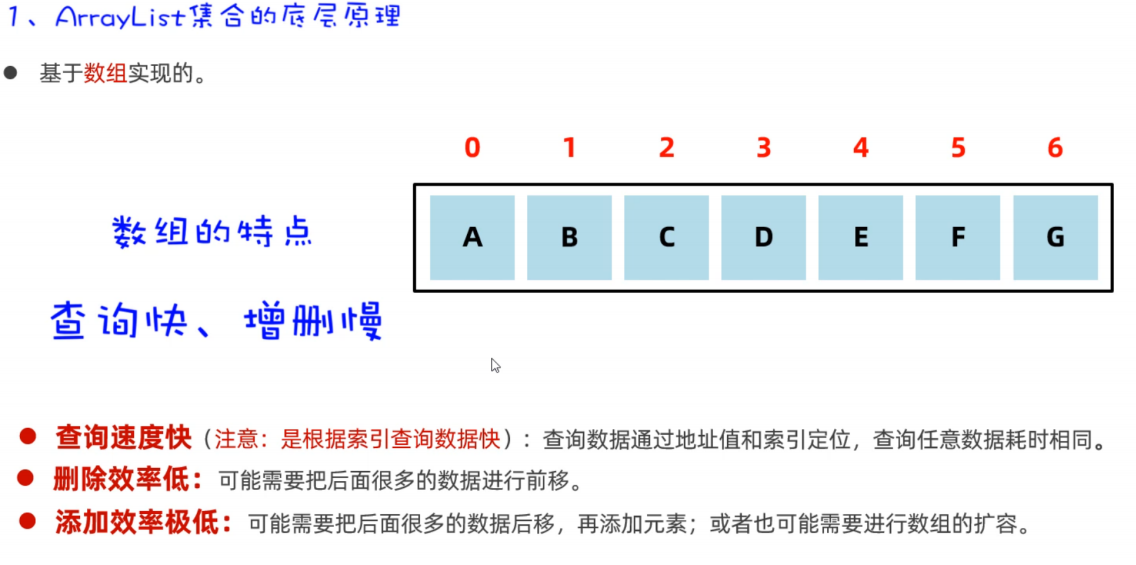
我们知道数组的长度是固定的,但是集合的长度是可变的,这是怎么做到的呢?原理如下:

1.3.4、LinkedList


1.3.4.1、LinkedList常用方法、

LInkedList 集合有什么用呢?可以用它来设计栈结构、队列结构。
队列结构你可以认为是一个上端开口,下端也开口的管子的形状。元素从上端入 队列,从下端出队列。
使用LinkedList设计栈结构、队列结构

入队列可以调用 LinkedList 集合的 addLast 方法,出队列可以调用 removeFirst() 方法 .
//1.创建一个队列:先进先出、后进后出
LinkedList<String> queue = new LinkedList<>(); //这是linkedlist独有的所以不能多态
//入对列
queue.addLast("第1号人");
queue.addLast("第2号人");
queue.addLast("第3号人");
queue.addLast("第4号人");
System.out.println(queue);
//出队列
System.out.println(queue.removeFirst()); //第4号人
System.out.println(queue.removeFirst()); //第3号人
System.out.println(queue.removeFirst()); //第2号人
System.out.println(queue.removeFirst()); //第1号人 栈结构的特点是先进后出,后进先出

接着,我们就用LinkedList来模拟下栈结构,代码如下:
//1.创建一个栈对象
LinkedList<String> stack = new LinkedList<>();
//压栈(push) 等价于 addFirst()
stack.push("第1颗子弹");
stack.push("第2颗子弹");
stack.push("第3颗子弹");
stack.push("第4颗子弹");
System.out.println(stack); //[第4颗子弹, 第3颗子弹, 第2颗子弹,第1颗子弹]
//弹栈(pop) 等价于 removeFirst()
System.out.println(statck.pop()); //第4颗子弹
System.out.println(statck.pop()); //第3颗子弹
System.out.println(statck.pop()); //第2颗子弹
System.out.println(statck.pop()); //第1颗子弹
//弹栈完了,集合中就没有元素了
System.out.println(list); //[] 1.4、Set系列集合(Set、HashSet、LinkedHashSet、TreeSet)


每一种 Set 集合的特点。(自己在idea上体会)
//Set<Integer> set = new HashSet<>(); // 无序、无索引、不重复
//Set<Integer> set = new LinkedHashSet<>(); // 有序、无索引、不重复
Set < Integer > set = new TreeSet <> (); // 可排序 ( 升序 ) 、无索引、不重复
set . add ( 666 );
set . add ( 555 );
set . add ( 555 );
set . add ( 888 );
set . add ( 888 );
set . add ( 777 );
set . add ( 777 );
System . out . println ( set ); //[555, 666, 777, 888]
1.4.1、HashSet集合
1.4.1.1、底层原理(了解)


往 HashSet 集合中存储元素时,底层调用了元素的两个方法:一个是 hashCode 方法获取元素的 hashCode 值(哈希值);另一个是调用了元素的equals 方法,用来比较新添加的元素和集合中已有的元素是否相同。
- 只有新添加元素的hashCode值和集合中以后元素的hashCode值相同、新添加的元素调用equals方法和集合中已有元素比较结果为true, 才认为元素重复。
- 如果hashCode值相同,equals比较不同,则以链表的形式连接在数组的同一个索引为位置(如上图所示)
在 JDK8 开始后,为了提高性能,当链表的长度超过8时,就会把链表转换为红黑树,如下图所示: 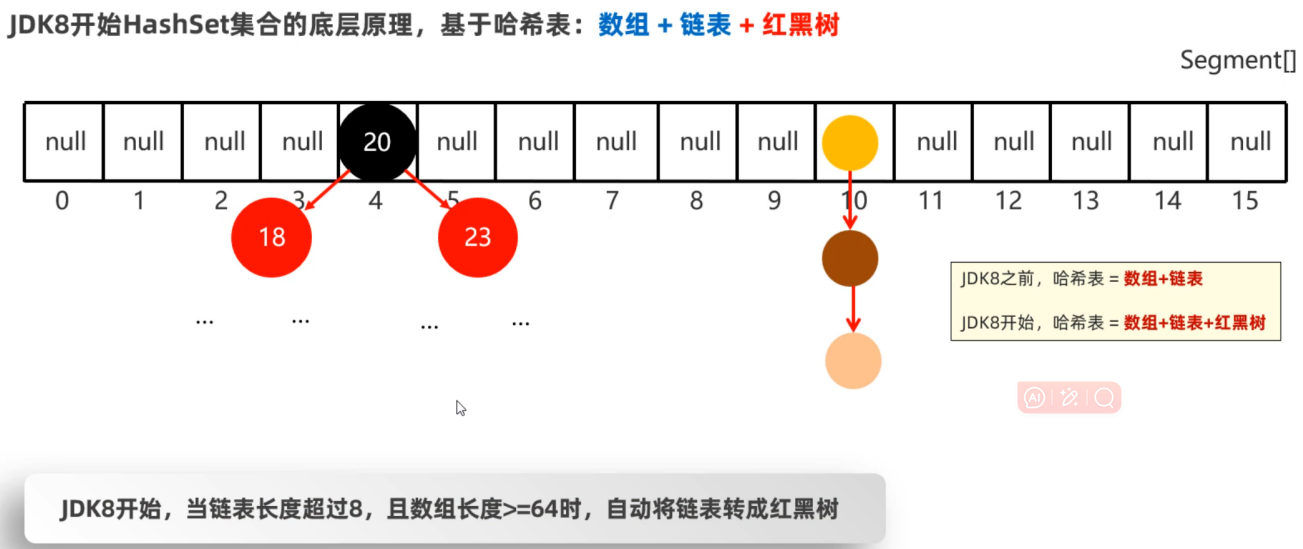

1.4.1.2、HashSet去重原理(重写hashcode、equals方法)
HashSet 存储元素的原理,依赖于两个方法:一个是 hashCode 方法用来确定在底层数组中存储的位置,另一个是用equals 方法判断新添加的元素是否和集合中已有的元素相同。
要想保证在 HashSet 集合中没有重复元素,需要重写元素类的 hashCode和equals 方法。比如以下面的 Student 类为例,假设把Student 类的对象作为 HashSet 集合的元素,想要让学生的姓名和年龄相同,就认为元素重复。
public class Student{private String name; //姓名private int age; //年龄private double height; //身高//无参数构造方法public Student(){}//全参数构造方法public Student(String name, int age, double height){this.name=name;this.age=age;this.height=height;}//...get、set、toString()方法自己补上..
//按快捷键生成hashCode和equals方法
//alt+insert 选择 hashCode and equals@Overridepublic boolean equals(Object o) {if (this == o) return true;if (o == null || getClass() != o.getClass()) return false;Student student = (Student) o;if (age != student.age) return false;if (Double.compare(student.height, height) != 0) return false;return name != null ? name.equals(student.name) : student.name == null;}@Overridepublic int hashCode() {int result;long temp;result = name != null ? name.hashCode() : 0;result = 31 * result + age;temp = Double.doubleToLongBits(height);result = 31 * result + (int) (temp ^ (temp >>> 32));return result;}
} 接着,写一个测试类,往 HashSet 集合中存储 Student 对象。
public class Test{public static void main(String[] args){Set<Student> students = new HashSet<>();Student s1 = new Student("至尊宝",20, 169.6);Student s2 = new Student("蜘蛛精",23, 169.6);Student s3 = new Student("蜘蛛精",23, 169.6);Student s4 = new Student("牛魔王",48, 169.6);students.add(s1);students.add(s2);students.add(s3);students.add(s4);for(Student s : students){System.out.println(s);}}
}
1.4.2、LinkedHashSet集合
HashSet 的子类 LinkedHashSet 类。 LinkedHashSet 它底层采用的是也是哈希表结构,只不
过额外新增了一个双向链表来维护元素的存取顺序。



public class Test{public static void main(String[] args){Set<Student> students = new LinkedHashSet<>();Student s1 = new Student("至尊宝",20, 169.6);Student s2 = new Student("蜘蛛精",23, 169.6);Student s3 = new Student("蜘蛛精",23, 169.6);Student s4 = new Student("牛魔王",48, 169.6);students.add(s1);students.add(s2);students.add(s3);students.add(s4);for(Student s : students){System.out.println(s);}}
} 打印结果如下

1.4.3、TreeSet集合
TreeSet 集合的特点是可以对元素进行排序,但是必须指定元素的排序规则。
1.如果往集合中存储 String类型的元素,或者Integer 类型的元素,它们本身就具备排序规则,所以直接就可以排序。
Set<Integer> set1= new TreeSet<>();
set1.add(8);
set1.add(6);
set1.add(4);
set1.add(3);
set1.add(7);
set1.add(1);
set1.add(5);
set1.add(2);
System.out.println(set1); //[1,2,3,4,5,6,7,8]Set<Integer> set2= new TreeSet<>();
set2.add("a");
set2.add("c");
set2.add("e");
set2.add("b");
set2.add("d");
set2.add("f");
set2.add("g");
System.out.println(set1); //[a,b,c,d,e,f,g] 2.如果往TreeSet集合中存储自定义类型的元素,比如说Student类型,则需要自己指定排序规则,否则会出现异常。
错误情况:
//创建TreeSet集合,元素为Student类型
Set<Student> students = new TreeSet<>();
//创建4个Student对象
Student s1 = new Student("至尊宝",20, 169.6);
Student s2 = new Student("紫霞",23, 169.8);
Student s3 = new Student("蜘蛛精",23, 169.6);
Student s4 = new Student("牛魔王",48, 169.6);
//添加Studnet对象到集合
students.add(s1);
students.add(s2);
students.add(s3);
students.add(s4);
System.out.println(students); 此时运行代码,会直接报错。原因是 TreeSet 不知道按照什么条件对 Student 对象来排序。
正确写法:
我们想要告诉 TreeSet 集合按照指定的规则排序,有两种办法:
- 第一种:让元素的类实现Comparable接口,重写compareTo方法
- 第二种:在创建TreeSet集合时,通过构造方法传递Compartor比较器对象
排序方式 1 :
//第一步:先让Student类,实现Comparable接口
//注意:Student类的对象是作为TreeSet集合的元素的
public class Student implements Comparable<Student>{private String name;private int age;private double height;//无参数构造方法public Student(){}//全参数构造方法public Student(String name, int age, double height){this.name=name;this.age=age;this.height=height;}//...get、set、toString()方法自己补上..
//第二步:重写compareTo方法
//按照年龄进行比较,只需要在方法中让this.age和o.age相减就可以。
/*
原理:
在往TreeSet集合中添加元素时,add方法底层会调用compareTo方法,根据该方法的
结果是正数、负数、还是零,决定元素放在后面、前面还是不存。
*/ @Overridepublic int compareTo(Student o) {
//this:表示将要添加进去的Student对象
//o: 表示集合中已有的Student对象return this.age-o.age;}
}
此时,再运行测试类,结果如下Student{name='至尊宝', age=20, height=169.6}Student{name='紫霞', age=20, height=169.8}Student{name='蜘蛛精', age=23, height=169.6}Student{name='牛魔王', age=48, height=169.6} 排序方式 2 :
//创建TreeSet集合时,传递比较器对象排序
/*
原理:当调用add方法时,底层会先用比较器,根据Comparator的compare方是正数、负数、还是零,决定谁在后,谁在前,谁不存。
*/
//下面代码中是按照学生的年龄升序排序
Set<Student> students = new TreeSet<>(new Comparator<Student>{@Overridepublic int compare(Student o1, Student o2){//需求:按照学生的身高排序return Double.compare(o1,o2);}
});
//创建4个Student对象
Student s1 = new Student("至尊宝",20, 169.6);
Student s2 = new Student("紫霞",23, 169.8);
Student s3 = new Student("蜘蛛精",23, 169.6);
Student s4 = new Student("牛魔王",48, 169.6);
//添加Studnet对象到集合
students.add(s1);
students.add(s2);
students.add(s3);
students.add(s4);
System.out.println(students); 2、各集合使用情况

3、集合的并发修改异常
其实就是删除一个元素后,集合位置会发生改变,但是索引接着往下走产生的原因,导致有些数据没办法被索引指到的问题
在使用迭代器遍历集合时,可能存在并发修改异常。
我们先把这个异常用代码演示出来,再解释一下为什么会有这个异常产生
List<String> list = new ArrayList<>();
list.add("王麻子");
list.add("小李子");
list.add("李爱花");
list.add("张全蛋");
list.add("晓李");
list.add("李玉刚");
System.out.println(list); // [王麻子, 小李子, 李爱花, 张全蛋, 晓李, 李玉刚]//需求:找出集合中带"李"字的姓名,并从集合中删除
Iterator<String> it = list.iterator();
while(it.hasNext()){String name = it.next();if(name.contains("李")){ list.remove(name);}
}
System.out.println(list); 运行上面的代码,会出现下面的异常。这就是并发修改异常

为什么会出现这个异常呢?那是因为迭代器遍历机制,规定迭代器遍历集合的同时,不允许集合自己去增删元素,否则就会出现这个异常。
使用for方法看,要加入i--才会执行成功

3.1解决方法
怎么解决这个问题呢?不使用集合的删除方法,而是使用迭代器的删除方法,代码如下:
List<String> list = new ArrayList<>();
list.add("王麻子");
list.add("小李子");
list.add("李爱花");
list.add("张全蛋");
list.add("晓李");
list.add("李玉刚");
System.out.println(list); // [王麻子, 小李子, 李爱花, 张全蛋, 晓李, 李玉刚]//需求:找出集合中带"李"字的姓名,并从集合中删除
Iterator<String> it = list.iterator();
while(it.hasNext()){String name = it.next();if(name.contains("李")){//list.remove(name);it.remove(); //当前迭代器指向谁,就删除谁}
}
System.out.println(list);

4、Collection其他使用
4.1、可变参数

public class ParamTest{public static void main(String[] args){//不传递参数,下面的nums长度则为0, 打印元素是[]test();//传递3个参数,下面的nums长度为3,打印元素是[10, 20, 30]test(10,20,30);//传递一个数组,下面数组长度为4,打印元素是[10,20,30,40]int[] arr = new int[]{10,20,30,40}test(arr);}public static void test(int...nums){
//可变参数在方法内部,本质上是一个数组System.out.println(nums.length);System.out.println(Arrays.toString(nums));System.out.println("----------------");}
}
4.2、Collections工具类
Collections 是用来操作Collection 的工具类

public class CollectionsTest{public static void main(String[] args){//1.public static <T> boolean addAll(Collection<? super T> c, T...e)对集合批量添加数据List<String> names = new ArrayList<>();Collections.addAll(names, "张三","王五","李四", "张麻子");System.out.println(names); //2.public static void shuffle(List<?> list):对List集合打乱顺序Collections.shuffle(names);System.out.println(names); //3.public static <T> void short(List<T list): 对List集合排序List<Integer> list = new ArrayList<>();list.add(3);list.add(5);list.add(2);Collections.sort(list);System.out.println(list);}
}
上面我们往集合中存储的元素要么是 Stirng 类型,要么是 Integer 类型,他们本来就有一种自然顺序所以可以直接排序。但是如果我们往List 集合中存储 Student 对象,这个时候想要对 List 集合进行排序自定义比较规则的。指定排序规则有两种方式,如下:
排序方式 1 :让元素实现 Comparable 接口,重写 compareTo 方法
比如现在想要往集合中存储 Studdent 对象,首先需要准备一个 Student 类,实现 Comparable 接口。
public class Student implements Comparable<Student>{private String name;private int age;private double height;//排序时:底层会自动调用此方法,this和o表示需要比较的两个对象@Overridepublic int compareTo(Student o){//需求:按照年龄升序排序//如果返回正数:说明左边对象的年龄>右边对象的年龄//如果返回负数:说明左边对象的年龄<右边对象的年龄,//如果返回0:说明左边对象的年龄和右边对象的年龄相同return this.age - o.age;}//...getter、setter、constructor..
} 然后再使用 Collections.sort(list 集合 ) 对 List 集合排序,如下:
//3.public static <T> void short(List<T list): 对List集合排序
List<Student> students = new ArrayList<>();
students.add(new Student("蜘蛛精",23,169.7));
students.add(new Student("紫霞",22,169.8));
students.add(new Student("紫霞",22,169.8));
students.add(new Student("至尊宝",26,169.5));
/*
原理:sort方法底层会遍历students集合中的每一个元素,采用排序算法,将任意两个元素两两比较;每次比较时,会用一个Student对象调用compareTo方法和另一个Student对象进行比较;根据compareTo方法返回的结果是正数、负数,零来决定谁大,谁小,谁相等,重新排序元素的位置注意:这些都是sort方法底层自动完成的,想要完全理解,必须要懂排序算法才行;
*/
Collections.sort(students);
System.out.println(students); 排序方式 2 :使用调用 sort 方法是,传递比较器
/*
原理:sort方法底层会遍历students集合中的每一个元素,采用排序算法,将任意两个元素两两比较;
每次比较,会将比较的两个元素传递给Comparator比较器对象的compare方法的两个参数o1和o2,
根据compare方法的返回结果是正数,负数,或者0来决定谁大,谁小,谁相等,重新排序元素的位置
注意:这些都是sort方法底层自动完成的,不需要我们完全理解,想要理解它必须要懂排序算法才行.
*/
Collections.sort(students, new Comparator<Student>(){@Overridepublic int compare(Student o1, Student o2){return o1.getAge()-o2.getAge();}
});
System.out.println(students); 